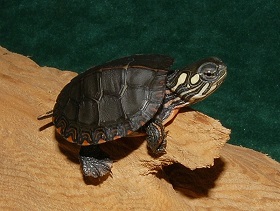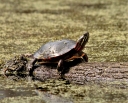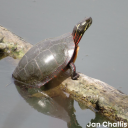Description: The Midland painted turtle (Chrysemys picta marginata) is a small to medium sized turtle capable of reaching straight carapace lengths of 5 to 9 inches. The body form is 'classic basking' style, very similar to a slider's. The carapace is smooth and lightly domed. Its shell ranges from a black to olive green with a vestigial vertebral stripe. The marginal scutes are may be decorated with red bars, blotches and stripes. The carapace scutes may also display light red lines along the borders of the carapacial scutes.
Midland Painted skin color is usually black to light green; the forearms display broad red lines. The head and throat have prominent yellow lines running from the tip of the nose and mouth downwards across the face. These lines will often turn red as they progress down towards the neck.
The upper jaw has pronounced 'tooth-like' cusps, and the eyes are generally yellow with a horizontal bar running through the pupil; they often have a yellow line or blotch directly behind the eye. The plastron can range from tan to red and usually displays a large colorful blotched pattern that may take up most of the plastron in some individuals, but can also be greatly reduced in others (western painteds have a more elaborate plastron 'color burst;' this is absent in southern & eastern painteds). Note: The plastron in some may be a darker color due to staining from organic compounds in the environment.
Male Midlands are generally smaller and less domed than their female counterparts, reaching around 5 inches adult SCL. Males don't show signs of plastral concavity as is the case with many other turtle species. Males have elongated front claws to aid in courtship and mating rituals. The tails are much longer than females and with the tail fully extended the cloaca will be past the edge of the carapace.
Habitat: To thrive, painted turtles need fresh waters with soft bottoms, basking sites, and aquatic vegetation. They find their homes in shallow waters with slow-moving currents, such as creeks, marshes, ponds, and the shores of lakes. The subspecies have evolved different habitat preferences. The midland and southern painted turtles seek especially quiet waters, usually shores and coves. They favor shallows that contain dense vegetation and have an unusual toleration of pollution.
Range: The midland painted turtle lives from southern Ontario and Quebec, through the eastern U.S. Midwest states, to Kentucky, Tennessee and northwestern Alabama, where it intergrades with the southern painted turtle. It also is found eastward through West Virginia, western Maryland and Pennsylvania. The midland painted turtle appears to be moving east, especially in Pennsylvania. To the northeast it is found in western New York and much of Vermont, and it intergrades extensively with the eastern subspecies.
Reproduction: The painted turtles mate in spring and fall in waters of 50 tbo 77℉. Males start producing sperm in early spring, when they can bask to an internal temperature of 63℉. Females begin their reproductive cycles in mid-summer, and ovulate the following spring.
Courtship begins when a male follows a female until he meets her face-to-face. He then strokes her face and neck with his elongated front claws, a gesture returned by a receptive female. The pair repeat the process several times, with the male retreating from and then returning to the female until she swims to the bottom, where they copulate. As the male is smaller than the female, he is not dominant. Although not directly observed, evidence indicates that the male will inflict injury on the female in attempts of coercion. Males will use their tooth-like cusps on their beaks and their foreclaws during this act of coercion with the female. The female stores sperm, to be used for up to three clutches, in her oviducts; the sperm may remain viable for up to three years. A single clutch may have multiple fathers.
Nesting is done, by the females only, between late May and mid-July. The nests are vase-shaped and are usually dug in sandy soil, often at sites with southern exposures. Nests are often within 220 yards of water, but may be as far away as 660 yards, with older females tending to nest further inland. Nest sizes vary depending on female sizes and locations but are about 2 to 4 inches deep. Females may return to the same sites several consecutive years, but if several females make their nests close together, the eggs become more vulnerable to predators. Female eastern painted turtles have been shown to nest together, possibly even participating in communal nesting.
The female's optimal body temperature while digging her nest is 84 to 86℉. If the weather is unsuitable, for instance a too hot night in the Southeast, she delays the process until later at night. Painted turtles in Virginia have been observed waiting three weeks to nest because of a hot drought.
While preparing to dig her nest, the female sometimes exhibits a mysterious preliminary behavior. She presses her throat against the ground of different potential sites, perhaps sensing moisture, warmth, texture, or smell, although her exact motivation is unknown. She may further temporize by excavating several false nests as the wood turtles also do.
The female relies on her hind feet for digging. She may accumulate so much sand and mud on her feet that her mobility is reduced, making her vulnerable to predators. To lighten her labors, she lubricates the area with her bladder water. Once the nest is complete, the female deposits into the hole. The freshly laid eggs are white, elliptical, porous, and flexible. From start to finish, the female's work may take four hours. Sometimes she remains on land overnight afterwards, before returning to her home water.
Females can lay five clutches per year, but two is a normal average after including the 30–50% of a population's females that do not produce any clutches in a given year. In some northern populations, no females lay more than one clutch per year. Bigger females tend to lay bigger eggs and more eggs per clutch. Clutch sizes of the subspecies vary, although the differences may reflect different environments, rather than different genetics. The two more northerly subspecies, western and midland, are larger and have more eggs per clutch—11.9 and 7.6, respectively—than the eastern (4.9). Within subspecies, also, the more northerly females lay larger clutches.








